Planting Grapevines 2015
We are planting grapevines in 2015! It seems that we have settled into a routine. A routine of planting 5 acres of grapes every other year!

Planting grapevines is such an exciting time for us. Besides expansion and growth, each acre planted means that the vineyard is moving closer to the house – we only have 4 more acres to go after this year’s planting and it will be up to the house!
This year we are planting 3 more acres of Montepulciano and 2 acres of Aglianico. Both are Italian red varieties that are late bud breaking and grow well in our west Texas environment!
Wondering what “late bud breaking” means? It means that they normally push out the first little green buds later in the season. For us, that is anywhere from late March to mid April. This is important in the years that there is a late freeze – like the last two years! If the buds are frozen, the crop is at the least decreased and can be completely lost! Early bud breaking varieties push their buds earlier which makes them more susceptible to freeze damage.
We use grafted vines because they are more nematode, cotton root rot and drought resistant. Often, a vine that produces a quality grape does not have a hardy root system. So, the roots are used from grapevines that grow well (and have other qualities you want for your growing area) and a good grape producing vine is grafted onto it – you get the best of both!
Lest you think that we are following into a rut, we did an experiment this year. In the past, we have only purchased bare root vines that have been grafted and raised in the field for one year.
In the photo below, you can see the single bare root grafted grapevine on the left and the bundle of 25 on the right.

This year, because of the lack of availability of the root stock we wanted, we purchased almost 350 potted vines. The potted plants arrived in 2″ x 2″ pots and many of them were already budded. That meant that planting had to be done carefully so as not to knock off the buds.
Below you can see a single potted grapevine on the left and the tray of pots standing up ready for planting on the right.

We had already done some preparation for planting by laying the underground drip irrigation tape a month or so ago. In addition to that tape, we also put another tape next to the vines during planting. This is called sacrificial tape because it will only be used for one year to water the young roots. After the first year, it will no longer be used.
Believe it or not, even more preparation for planting had to be done before the actual planting could begin. After all, we want straight evenly spaced rows and plants! So, we borrowed a friend’s tractor with GPS on it to insure the rows would be straight.
Now, to insure the plants would be evenly spaced and line up with the existing vineyard, marks were made across the rows of the new planting. These marks are then used by the person planting to know when to plant a vine.
To mark, the tractor with the marking plow attached, was backed up to the last existing row and driven (marking the ground as it went) across the rows of the new planting.

The marks left are deep which make it easy to know where the vines are to be planted.
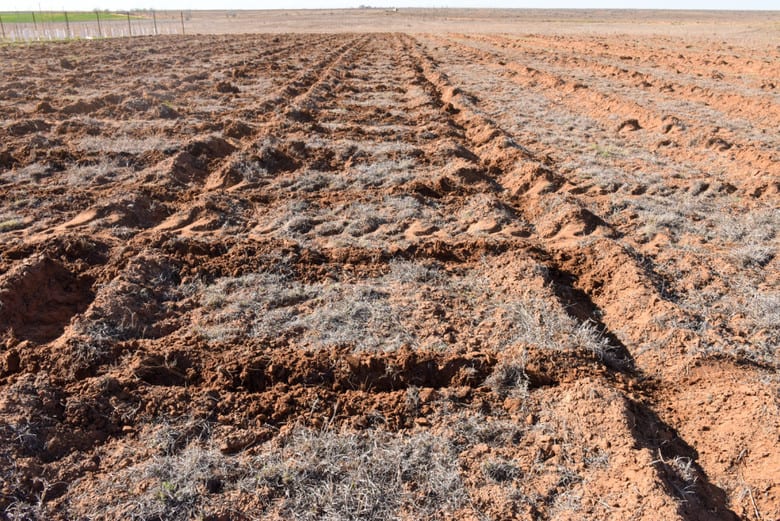
The grapevines are placed in the large silver bin that you can see on the planter. Water is put into the bottom of the bins to keep the vines wet.
Grapevines are handed to the planter, one at a time. The person planting watches as the tractor moves down the row for the marks indicating vine placement. When lined up with the mark, a grapevine is placed into the dirt.

Underneath the planter there is a large shank that cuts and breaks the dirt. You can also see the pipe that feeds the sacrificial irrigation drip tape.
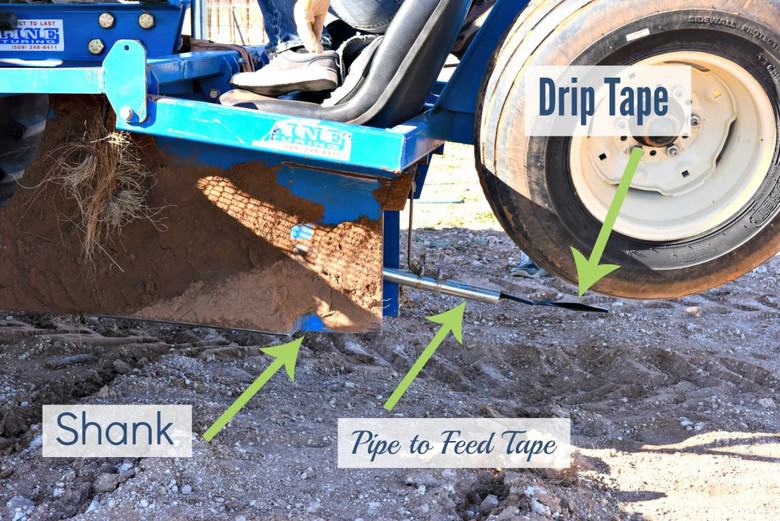
The tires that you see on the back of the planting rig cover the vine and pack the dirt around it. Here is the vine just put into the ground.
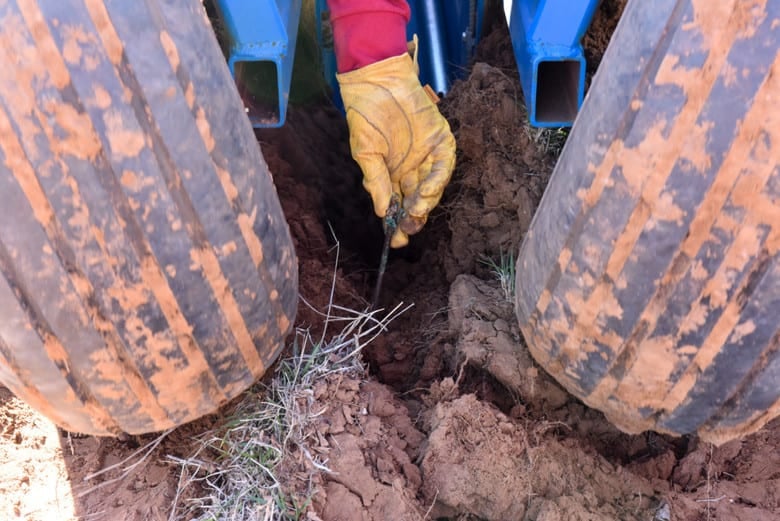
Now the tires go around it packing the dirt.
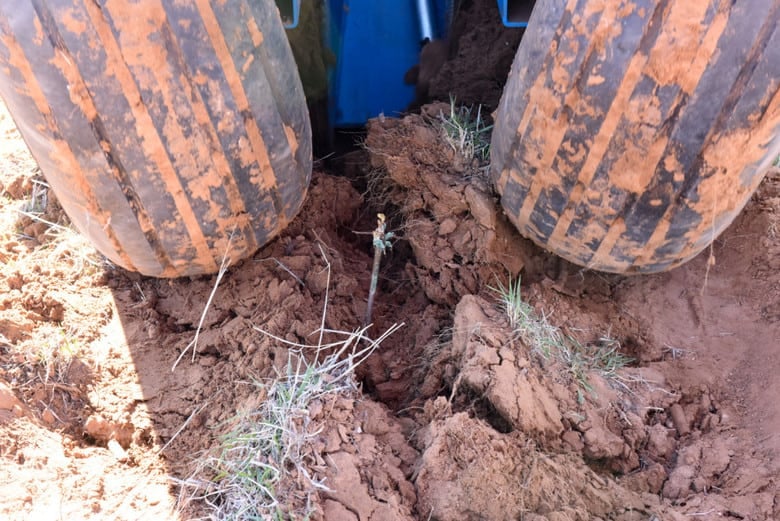
Several people walk behind the planter making sure the vines are on the mark, standing up straight and the dirt well packed.
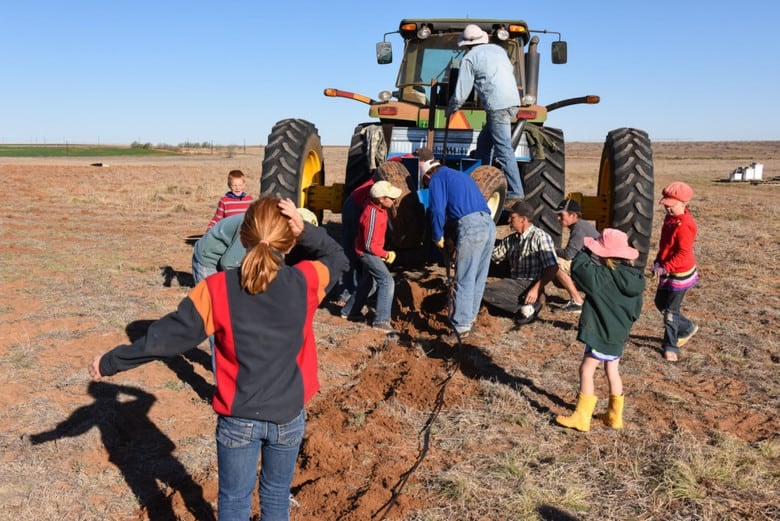
As the rows were completed, John began connecting the underground drip irrigation. At the end of the day, the wells were turned on to flush out the tapes and begin watering the vines.
We were able to finish planting the whole five acres in one day. Afterwards came party time – complete with wine and snacks!
If you enjoyed reading planting grapevines 2015, be sure to check out the links below!

Thank you for sharing this mysterious process! Have you always known how to farm or read lots of books? What a learning curve it must be. Congratulations!!!
Megan, we knew nothing about farming before beginning the vineyard – it was definitely a leap of faith!
This was truly fascinating. I have seen this with strawberry plants. So glad you shared.
Thanks, Jessica!